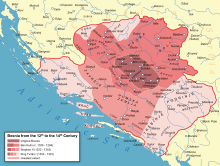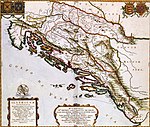| Banate of Bosnia | |||||||||
|---|---|---|---|---|---|---|---|---|---|
| Banate of the Kingdom of Hungary | |||||||||
| 1154–1377 | |||||||||
 Territorial evolution of Bosnia | |||||||||
| History | |||||||||
• Established | 1154 | ||||||||
• Tvrtko I crowned King of Bosnia | 1377 | ||||||||
| |||||||||
| Today part of | |||||||||
| History of Bosnia and Herzegovina |
|---|
 |
|
|
The Banate of Bosnia (Serbo-Croatian: Banovina Bosna / Бановина Босна), or Bosnian Banate (Bosanska banovina / Босанска бановина), was a medieval state located in what is today Bosnia and Herzegovina. Although Hungarian kings viewed Bosnia as part of Hungarian Crown Lands, the Banate of Bosnia was a de facto independent state for most of its existence.[1][2][3] It was founded in the mid-12th century and existed until 1377 with interruptions under the Šubić family between 1299 and 1324. In 1377, it was elevated to a kingdom. The greater part of its history was marked by a religiopolitical controversy revolving around the native Christian Bosnian Church condemned as heretical by the dominant Chalcedonian Christian churches, namely the Catholic and Eastern Orthodox churches, with the Catholic Church being particularly antagonistic and persecuting its members through the Hungarians.[4][5]
- ^ Fine 1994, pp. 44, 148.
- ^ Paul Mojzes. Religion and the war in Bosnia. Oxford University Press, 2000, p 22; "Medieval Bosnia was founded as an independent state by Ban Kulin (1180-1204).".
- ^ Vego 1982, p. 104.
- ^ Bringa, Tone (1995). Being Muslim the Bosnian Way. Princeton University Press. pp. 15. ISBN 978-0-691-00175-3.
- ^ Curta 2006, p. 433–434.

